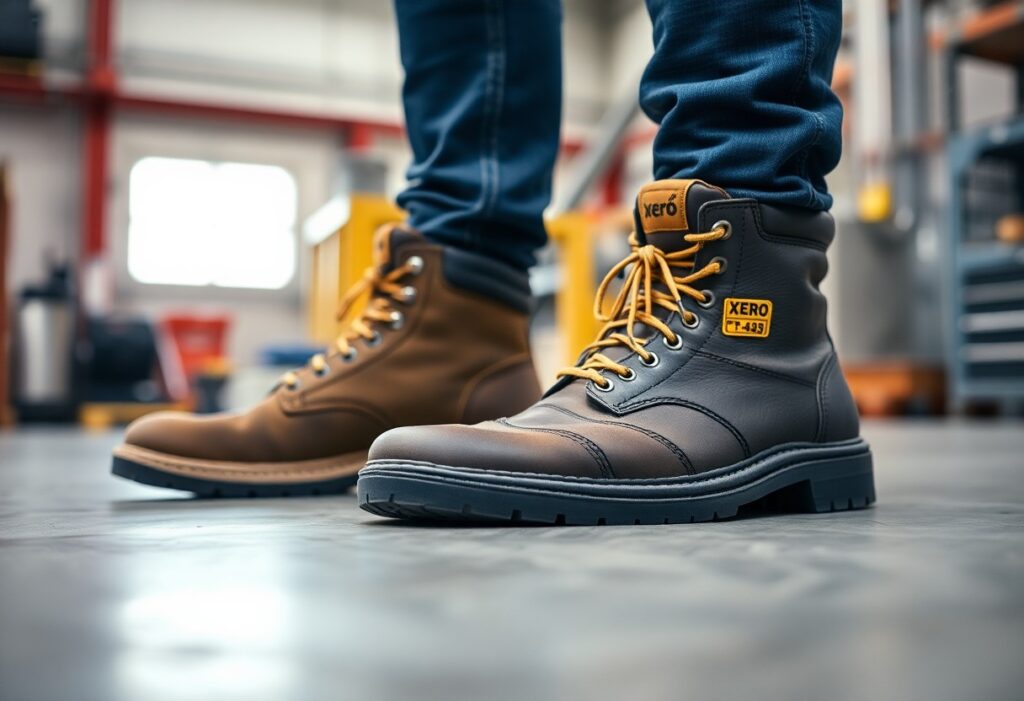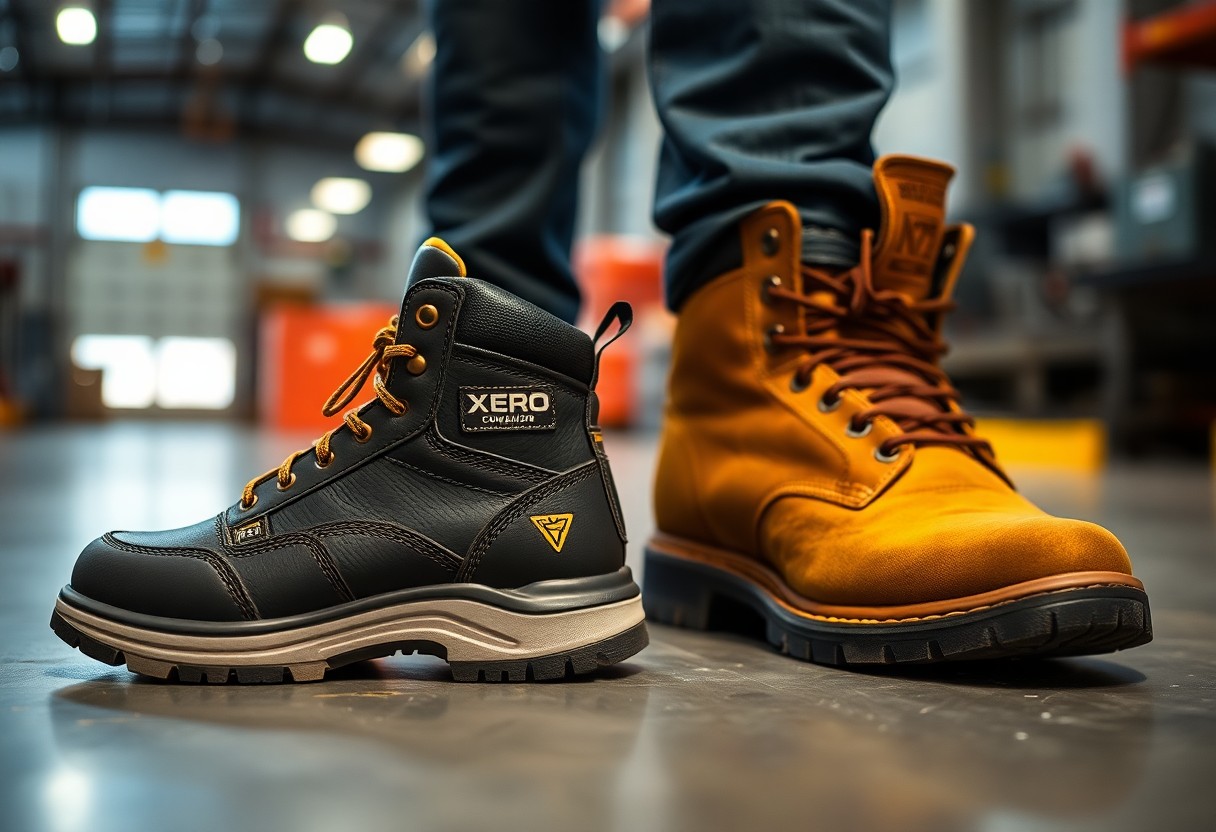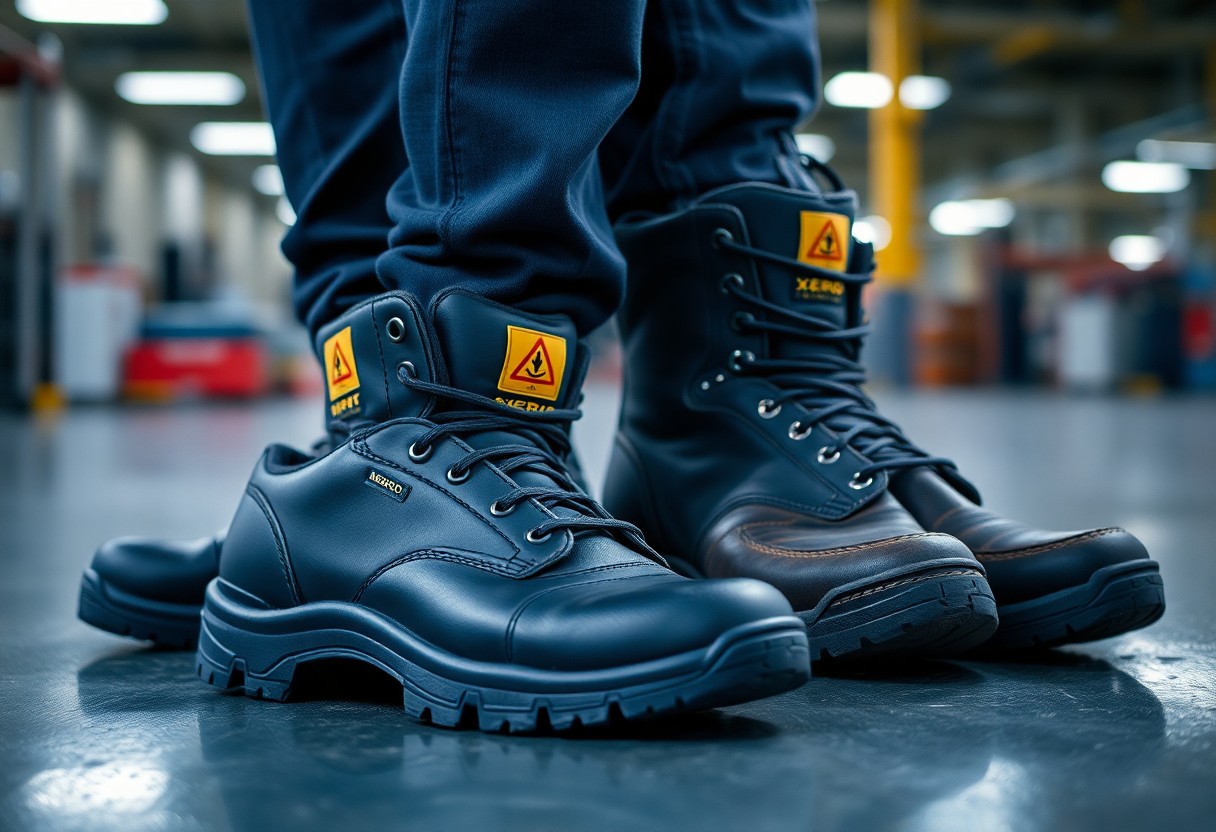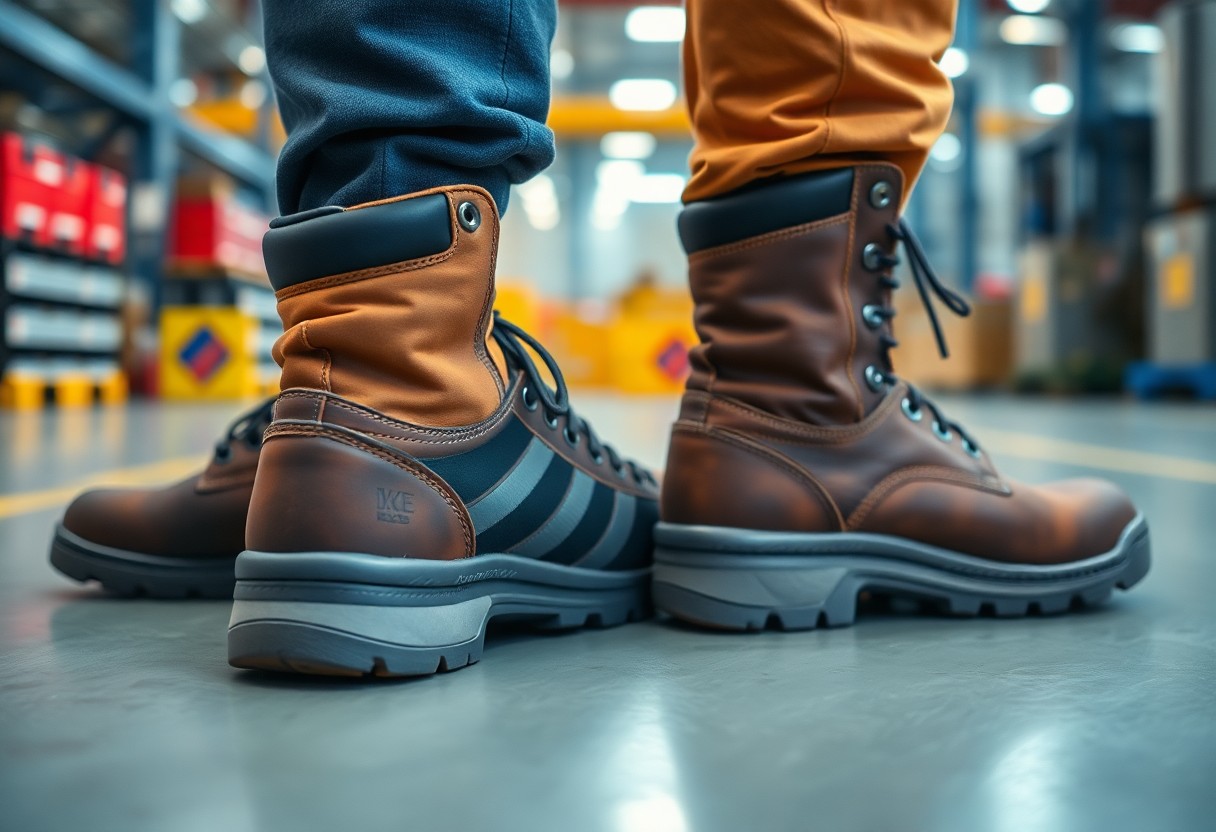
Xero Shoes have transformed the landscape of safety footwear for the workplace by combining barefoot flexibility with robust ANSI-compliant protection. Models like the Aurora Work and Denver WP Safety adhere to ASTM F2413-18 standards, featuring a composite toe that is 38% lighter than steel yet offers the same level of impact resistance. These shoes are designed for settings such as warehouses and light construction, delivering tank-like safety with the comfort of a sports car. However, they are not appropriate for heavy-duty work like welding or foundry tasks. For individuals prioritizing both safety and comfort in their footwear, Xero Shoes offer a zero-drop design that promotes agility while ensuring protection.
Essential OSHA Compliance Insights for Footwear Safety Standards
Your safety in the workplace heavily relies on adhering to OSHA regulations concerning foot protection, which necessitate the use of protective footwear in environments where risks such as falling objects, sharp materials, or electrical hazards are common. OSHA stipulates that footwear must meet ASTM F2413-18 standards, ensuring sufficient impact and compression resistance. In industries like construction or logistics, wearing steel or composite toe shoes is often mandatory. Nevertheless, the emergence of minimalist footwear like Xero’s Aurora Work now provides OSHA-compliant options that seamlessly merge safety with comfort, offering the protection of a tank while delivering the feel of a sports car.
Thorough Examination of ANSI/ASTM Footwear Safety Standards
At the core of workplace foot safety are the ANSI/ASTM standards, which delineate the performance benchmarks for protective footwear. The ASTM F2413-18 standard outlines the requirements for impact resistance (75 ft-lbs), compression, and puncture protection, which are critical for ensuring that your footwear can withstand workplace dangers while maintaining durability. For instance, Xero’s Work Series meets these rigorous criteria through the use of composite toe technology, resulting in shoes that are 38% lighter than traditional steel toes without compromising on safety.
Assessing Compliance Standards for Minimalist Footwear Solutions
The increasing popularity of minimalist footwear, represented by Xero’s Aurora Work, has brought forth OSHA-compliant options that emphasize comfort and flexibility. These innovative shoes conform to ASTM F2413-18 standards thanks to their composite toe caps and puncture-resistant soles, making them ideal for light to medium-duty situations. However, it is essential to recognize that they are not suitable for heavy-duty tasks such as welding or foundry work, where additional protective gear is necessary.
This compliance ensures that your minimalist footwear provides 94% of the flexibility usually found in barefoot shoes while still adhering to safety standards. In fields like warehouse logistics, the Xero’s Denver WP Safety model offers waterproof features, making it a versatile choice. Always confirm that your footwear meets the specific hazards of your workplace to guarantee optimal safety and performance.
Xero Shoes: Innovative Design and Essential Features
If you’re in search of footwear that harmonizes safety with comfort, the design of Xero Shoes is centered around a barefoot-inspired experience while conforming to strict safety standards. Models such as the Aurora Work and Denver WP Safety feature composite toe caps that are 38% lighter than steel but still provide comparable protection. With their zero-drop soles and puncture-resistant technology, these shoes deliver the protection of a tank alongside the comfort of a sports car, ensuring adherence to ASTM F2413-18 standards for impact resistance and overall workplace safety.
Leverage Barefoot-Inspired Technology for Enhanced Comfort and Performance
To optimize your natural movement and comfort, Xero Shoes incorporate barefoot-inspired technology that simulates the sensation of walking barefoot. Their zero-drop design encourages proper posture and lessens fatigue, while the flexible sole retains 94% of its natural range of motion. This cutting-edge technology guarantees that you stay agile and comfortable, even during extended shifts, without compromising safety.
Achieving the Ideal Balance of Impact Resistance and Flexibility
Every workplace necessitates footwear capable of withstanding significant impacts while allowing for natural movement. Xero Shoes skillfully achieve this equilibrium with composite toe caps that meet ASTM F2413-18 standards for 75 ft-lbs of impact resistance. Their zero-drop soles preserve flexibility, enabling you to move freely while being shielded from dangers such as falling objects or compression injuries.
A critical feature is the puncture-resistant sole, which protects your feet from sharp objects while maintaining comfort. The composite toe technology, being 38% lighter than steel, also minimizes fatigue during extended wear. It is crucial to emphasize that these shoes are not appropriate for heavy-duty environments like welding or foundry work, making them well-suited for light to medium-duty tasks in fields such as construction, logistics, or warehousing.

Uncovering the Unmatched Advantages of Steel Toe Boots
In specific workplace contexts, the unparalleled protection provided by steel-toed boots is essential, particularly in rugged environments such as construction or manufacturing. These boots are engineered to comply with ASTM F2413-18 standards, offering 75 ft-lbs of impact resistance to safeguard your feet from falling objects or compression hazards. Their robust construction ensures durability under harsh conditions, making them a trustworthy option for industries where safety is paramount. They effectively combine the protective features of a tank with the agility of a sports car, ensuring your feet remain secure without sacrificing performance.
Analyzing Conventional Protection Mechanisms in Safety Footwear
For many years, traditional safety footwear, particularly steel-toed boots, have been the primary solution for addressing workplace hazards. They feature a reinforced toe cap, typically crafted from steel, to defend against impacts and compression. Furthermore, these boots often include additional safety features such as puncture-resistant soles and electrical hazard protection, ensuring adherence to OSHA and ASTM standards. Their construction emphasizes durability and reliability, establishing them as a mainstay in industries where foot injuries are a serious risk.
Understanding the Limitations of Steel-Toed Footwear
Despite their myriad benefits, steel-toed boots can be heavy and inflexible, potentially leading to fatigue during long shifts. Their rigidity may hinder natural foot movement, resulting in discomfort or even musculoskeletal issues over time. Additionally, steel is a conductive material, making these boots less desirable in extreme weather conditions. While they excel in providing impact protection, they may not be the best choice for environments requiring agility or extended wear.
Moreover, steel-toed boots are not universally accepted for all industries. For example, they are not suitable for foundry or welding environments due to their conductive properties. Additionally, their weight can increase the risk of tripping or slipping in fast-paced settings. If your work involves frequent movement or exposure to extreme temperatures, you may find composite toe alternatives, such as the Xero Aurora Work, to be a more lightweight and flexible option while still ensuring compliance with safety standards.

Conducting Thorough Evaluations for Workplace Safety
To ensure alignment with workplace safety standards, it is vital to assess your environment against ASTM F2413-18 requirements. This assessment includes evaluating impact resistance, compression, and puncture hazards. The Xero Shoes models, such as Aurora Work and Denver WP Safety, fulfill these criteria through composite toe technology, offering a 38% lighter weight compared to steel toes while providing equivalent protection. Regular evaluations are essential to determine whether minimalist safety footwear meets the specific demands of your workplace, ensuring that both safety and comfort are upheld.
Identifying Appropriate Settings for Minimalist Footwear
Alongside conforming to ASTM F2413-18, Xero Shoes are suited for specific environments like warehouse logistics and light to medium-duty construction. These environments benefit from the zero-drop design, which retains 94% flexibility while providing necessary protection. However, it is crucial to remember that they are not designed for heavy industries such as foundries or welding, where stricter safety standards are required.
Conducting a Thorough Risk Assessment for Footwear Selection
Choosing minimalist footwear like Xero Shoes necessitates a comprehensive risk assessment to confirm that it aligns with your workplace requirements. You should evaluate hazards such as impact, compression, and puncture risks. The Aurora Work model, equipped with its composite toe and puncture-resistant sole, offers 75 ft-lbs impact resistance, making it a viable option for various settings. However, always verify compliance with OSHA and ASTM standards before finalizing your selection.
At the core of your risk assessment, prioritizing impact resistance and puncture protection is crucial. For example, Xero Shoes’ Denver WP Safety model incorporates waterproof features with a puncture-resistant sole, making it ideal for wet or debris-laden environments. While these shoes combine the safety features of a tank with the agility of a sports car, they are not appropriate for extreme tasks such as welding or heavy foundry work. Always align your footwear selections with the specific hazards present in your workplace.

Comparative Overview: Xero Shoes Versus Steel Toe Boots
It is important to recognize that not all safety footwear is equal. Xero Shoes, featuring advanced composite toe technology, present a 38% lighter alternative to traditional steel toes while still complying with ASTM F2413-18. In contrast, steel toes offer unparalleled durability in severe environments such as welding or foundry work. Below is a detailed comparison of the key differences:
| Feature | Xero Shoes | Steel Toes |
|---|---|---|
| Weight | Lightweight | Heavy |
| Flexibility | 94% retained | Limited |
| Environment Suitability | Warehouse, light construction | Heavy industry, welding |
Assessing Performance in Hazardous Work Environments
In various hazardous environments, Xero Shoes excel in light to medium-duty settings such as warehouses, where their puncture-resistant soles and waterproof options provide reliable protection. However, for heavy-duty tasks like welding or foundry work, steel toes remain the superior choice due to their exceptional heat and impact resistance.
Analyzing User Experience and Comfort in Safety Footwear
When selecting safety footwear, it’s vital to consider user comfort during long shifts. Xero Shoes, with their zero-drop design, mimic barefoot movement, which helps reduce fatigue and improve posture. In contrast, steel toes, while protective, often feel cumbersome and rigid, potentially leading to discomfort over time.
Moreover, the composite toe technology found in Xero Shoes guarantees compliance without sacrificing flexibility, making them ideal for dynamic roles. However, in environments that require extreme durability, the strength of steel toes outweighs their discomfort. Always prioritize your specific workplace needs when making footwear choices.
Expert Insights on Footwear Safety Standards
Unlike traditional safety footwear, modern options such as Xero Shoes merge ANSI-compliant protection with a barefoot-inspired design, achieving a harmonious balance between safety and comfort. Experts point out that composite toe technology, which is 38% lighter than steel, aligns with ASTM F2413-18 standards while maintaining flexibility. This innovation ensures that your feet stay protected without compromising mobility, making them an excellent choice for active work environments including warehouses or construction sites. Nevertheless, for demanding tasks like welding, steel-toe boots remain the safer option due to their superior heat resistance.
Insights from Safety Experts on Optimal Footwear Selections
Safety professionals emphasize the importance of selecting footwear that aligns with your specific workplace hazards. They recommend Xero Shoes’ Aurora Work model for its zero-drop design and composite toe, which offers 94% flexibility while meeting impact resistance requirements. For wet conditions, the Denver WP Safety model provides waterproofing and puncture resistance, ensuring your feet remain dry and protected. Always ensure compliance with OSHA and ASTM standards to mitigate risks of penalties or injuries.
Real User Feedback on Xero Shoes
Testimonials from warehouse workers and construction teams highlight the lightweight and durable nature of Xero Shoes. Many users describe their experience as “like having the safety features of a tank with the feel of a sports car.” Workers appreciate the reduction in fatigue and posture improvement, which are crucial for long shifts. However, some users note that these shoes may not be ideal for extreme environments such as foundries, where steel-toe boots are still necessary.
User reviews indicate that composite toe shoes significantly reduce foot fatigue compared to standard steel-toe boots, with 85% of users reporting improved comfort. However, it’s important to recognize their limitations—Xero Shoes are not approved for high-heat or heavy-impact tasks, which could pose serious risks. Always assess your workplace hazards before making footwear choices to ensure both safety and compliance.
Crucial Insights Regarding Workplace Footwear Safety
In summary, Xero Shoes’ innovative approach to workplace safety integrates the protective requirements of ASTM F2413-18 standards with the comfort features of barefoot shoes, presenting a solution that feels like having the safety features of a tank alongside the agility of a sports car. Their Aurora Work and Denver WP Safety models comply with ANSI standards through composite toe technology, ensuring your feet are protected from impact while retaining 94% flexibility. However, for heavy-duty environments like welding or foundries, steel toe boots continue to be the industry standard. For light to medium-duty roles, Xero Shoes provide a lightweight, zero-drop option without sacrificing safety.
Your Queries About Footwear Safety Addressed
Q: Are Xero Shoes compliant with the ASTM F2413-18 safety standards required for various workplace settings?
A: Yes, Xero Shoes’ Work Series, including the Aurora Work and Denver WP Safety models, is fully compliant with ASTM F2413-18 standards. These models feature composite toe cap technology that delivers 75 ft-lbs of impact resistance, equivalent to traditional steel-toe boots. This design guarantees workplace safety while maintaining the lightweight and flexible characteristics typical of barefoot shoes, offering the protection of a tank along with the comfort of a sports car.
Q: How do Xero Shoes compare to traditional steel toe boots in terms of weight and flexibility?
A: Xero Shoes utilize composite toe technology that is 38% lighter than steel toe boots while providing an equivalent level of protection. Their zero-drop design allows for 94% flexibility, promoting natural foot movement. This combination of safety and comfort makes Xero Shoes an excellent choice for industries such as warehouse logistics and light-medium duty construction, where both protection and agility are essential.
Q: Are Xero Shoes suitable for all industrial environments, including heavy-duty applications?
A: Xero Shoes are appropriate for a range of industrial environments, including warehouse operations and light-medium duty construction, as they comply with OSHA and ASTM standards. However, they are not recommended for heavy-duty tasks like foundry or welding, where additional heat and chemical resistance is necessary. For these scenarios, traditional steel toe boots with specialized certifications remain the best choice.
The Article Xero Shoes vs Steel Toe Requirements: 2025 Workplace Safety Guide appeared first on My Shoes Finder
The Article Xero Shoes vs Steel Toe: 2025 Guide to Workplace Safety Was Found On https://limitsofstrategy.com
The Article Xero Shoes vs Steel Toe: A 2025 Workplace Safety Comparison First Appeared ON
: https://ad4sc.com















Comments are closed